Suorong Yang
Exposing Hallucinations To Suppress Them: VLMs Representation Editing With Generative Anchors
Sep 26, 2025Abstract:Multimodal large language models (MLLMs) have achieved remarkable success across diverse vision-language tasks, yet they remain highly susceptible to hallucinations, producing content that is fluent but inconsistent with visual evidence. Such hallucinations, spanning objects, attributes, and relations, persist even in larger models, while existing mitigation approaches often require additional finetuning, handcrafted priors, or trade-offs that compromise informativeness and scalability. To address this limitation, we propose a training-free, self-supervised method for hallucination mitigation. Our approach introduces a novel hallucination amplification mechanism: a caption is projected into the visual space via a text-to-image model to reveal implicit hallucination signals, serving as a negative anchor, while the original image provides a positive anchor. Leveraging these dual anchors, we edit decoder hidden states by pulling representations toward faithful semantics and pushing them away from hallucination directions. This correction requires no human priors or additional training costs, ensuring both effectiveness and efficiency. Extensive experiments across multiple benchmarks show that our method significantly reduces hallucinations at the object, attribute, and relation levels while largely preserving recall and caption richness, e.g., achieving a hallucination reduction by over 5% using LLaVA-v1.5-7B on CHAIR. Furthermore, results on diverse architectures, including LLaVA-NEXT-7B, Cambrian-8B, and InstructBLIP-7B, validate strong cross-architecture generalization. More importantly, when applied to hallucination-free captions, our method introduces almost no side effects, underscoring its robustness and practical plug-and-play applicability. The implementation will be publicly available.
RL-Selector: Reinforcement Learning-Guided Data Selection via Redundancy Assessment
Jun 26, 2025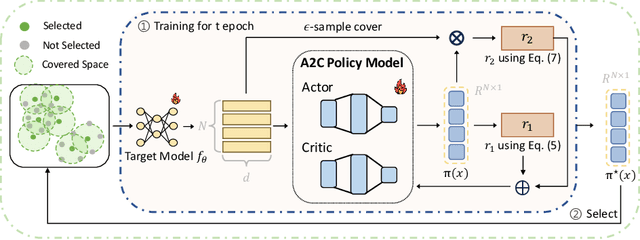
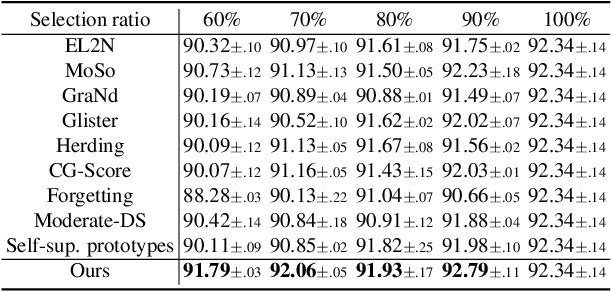
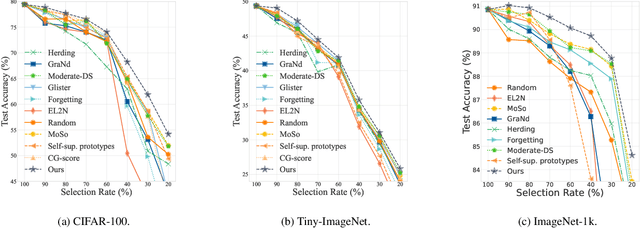

Abstract:Modern deep architectures often rely on large-scale datasets, but training on these datasets incurs high computational and storage overhead. Real-world datasets often contain substantial redundancies, prompting the need for more data-efficient training paradigms. Data selection has shown promise to mitigate redundancy by identifying the most representative samples, thereby reducing training costs without compromising performance. Existing methods typically rely on static scoring metrics or pretrained models, overlooking the combined effect of selected samples and their evolving dynamics during training. We introduce the concept of epsilon-sample cover, which quantifies sample redundancy based on inter-sample relationships, capturing the intrinsic structure of the dataset. Based on this, we reformulate data selection as a reinforcement learning (RL) process and propose RL-Selector, where a lightweight RL agent optimizes the selection policy by leveraging epsilon-sample cover derived from evolving dataset distribution as a reward signal. Extensive experiments across benchmark datasets and diverse architectures demonstrate that our method consistently outperforms existing state-of-the-art baselines. Models trained with our selected datasets show enhanced generalization performance with improved training efficiency.
* ICCV 2025
Position: Intelligent Science Laboratory Requires the Integration of Cognitive and Embodied AI
Jun 24, 2025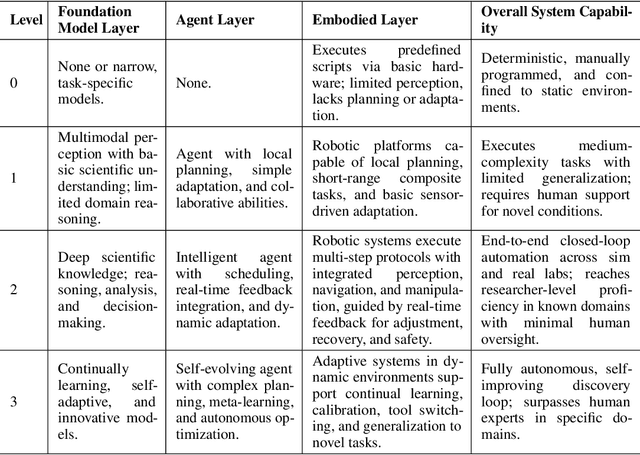
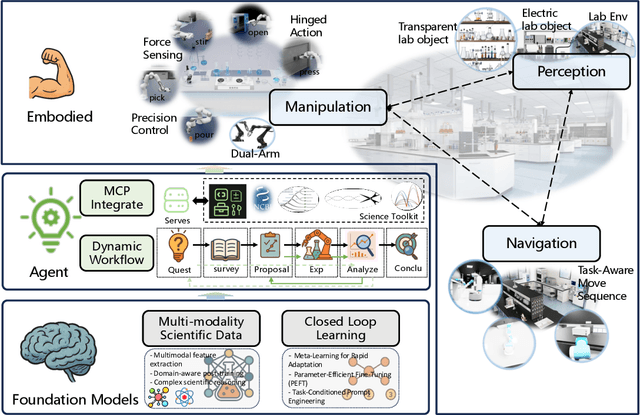
Abstract:Scientific discovery has long been constrained by human limitations in expertise, physical capability, and sleep cycles. The recent rise of AI scientists and automated laboratories has accelerated both the cognitive and operational aspects of research. However, key limitations persist: AI systems are often confined to virtual environments, while automated laboratories lack the flexibility and autonomy to adaptively test new hypotheses in the physical world. Recent advances in embodied AI, such as generalist robot foundation models, diffusion-based action policies, fine-grained manipulation learning, and sim-to-real transfer, highlight the promise of integrating cognitive and embodied intelligence. This convergence opens the door to closed-loop systems that support iterative, autonomous experimentation and the possibility of serendipitous discovery. In this position paper, we propose the paradigm of Intelligent Science Laboratories (ISLs): a multi-layered, closed-loop framework that deeply integrates cognitive and embodied intelligence. ISLs unify foundation models for scientific reasoning, agent-based workflow orchestration, and embodied agents for robust physical experimentation. We argue that such systems are essential for overcoming the current limitations of scientific discovery and for realizing the full transformative potential of AI-driven science.
When Dynamic Data Selection Meets Data Augmentation
May 02, 2025
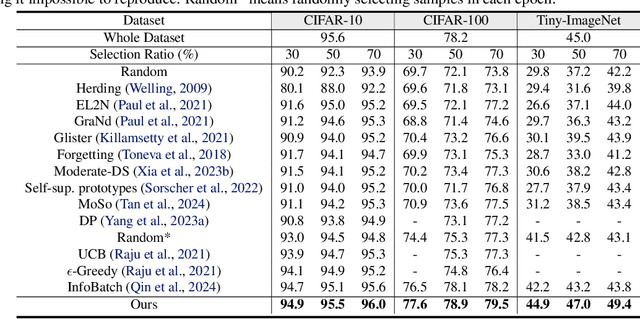

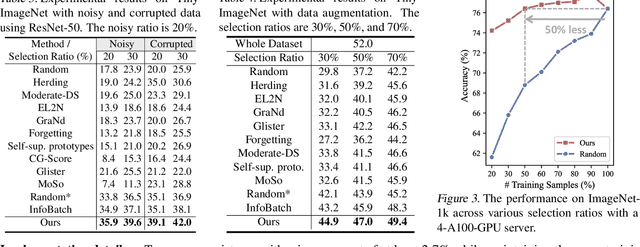
Abstract:Dynamic data selection aims to accelerate training with lossless performance. However, reducing training data inherently limits data diversity, potentially hindering generalization. While data augmentation is widely used to enhance diversity, it is typically not optimized in conjunction with selection. As a result, directly combining these techniques fails to fully exploit their synergies. To tackle the challenge, we propose a novel online data training framework that, for the first time, unifies dynamic data selection and augmentation, achieving both training efficiency and enhanced performance. Our method estimates each sample's joint distribution of local density and multimodal semantic consistency, allowing for the targeted selection of augmentation-suitable samples while suppressing the inclusion of noisy or ambiguous data. This enables a more significant reduction in dataset size without sacrificing model generalization. Experimental results demonstrate that our method outperforms existing state-of-the-art approaches on various benchmark datasets and architectures, e.g., reducing 50\% training costs on ImageNet-1k with lossless performance. Furthermore, our approach enhances noise resistance and improves model robustness, reinforcing its practical utility in real-world scenarios.
Critic-V: VLM Critics Help Catch VLM Errors in Multimodal Reasoning
Dec 02, 2024



Abstract:Vision-language models (VLMs) have shown remarkable advancements in multimodal reasoning tasks. However, they still often generate inaccurate or irrelevant responses due to issues like hallucinated image understandings or unrefined reasoning paths. To address these challenges, we introduce Critic-V, a novel framework inspired by the Actor-Critic paradigm to boost the reasoning capability of VLMs. This framework decouples the reasoning process and critic process by integrating two independent components: the Reasoner, which generates reasoning paths based on visual and textual inputs, and the Critic, which provides constructive critique to refine these paths. In this approach, the Reasoner generates reasoning responses according to text prompts, which can evolve iteratively as a policy based on feedback from the Critic. This interaction process was theoretically driven by a reinforcement learning framework where the Critic offers natural language critiques instead of scalar rewards, enabling more nuanced feedback to boost the Reasoner's capability on complex reasoning tasks. The Critic model is trained using Direct Preference Optimization (DPO), leveraging a preference dataset of critiques ranked by Rule-based Reward~(RBR) to enhance its critic capabilities. Evaluation results show that the Critic-V framework significantly outperforms existing methods, including GPT-4V, on 5 out of 8 benchmarks, especially regarding reasoning accuracy and efficiency. Combining a dynamic text-based policy for the Reasoner and constructive feedback from the preference-optimized Critic enables a more reliable and context-sensitive multimodal reasoning process. Our approach provides a promising solution to enhance the reliability of VLMs, improving their performance in real-world reasoning-heavy multimodal applications such as autonomous driving and embodied intelligence.
Integrating Dual Prototypes for Task-Wise Adaption in Pre-Trained Model-Based Class-Incremental Learning
Nov 26, 2024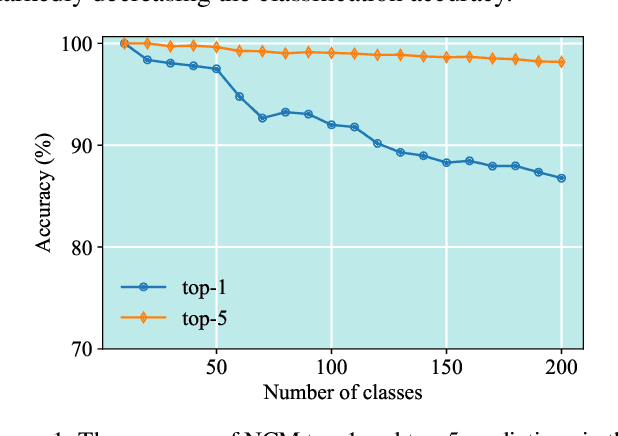
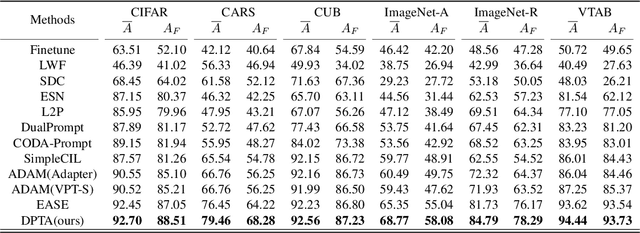
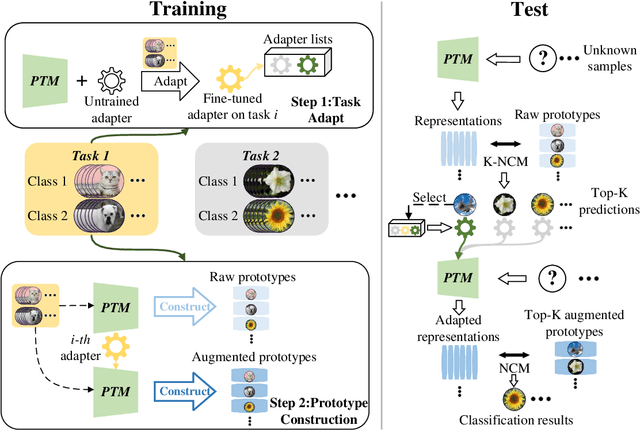
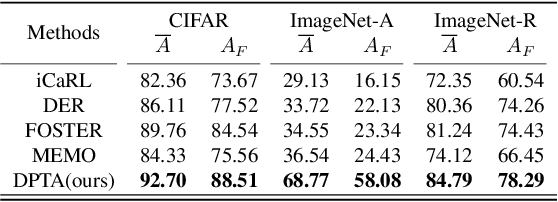
Abstract:Class-incremental learning (CIL) aims to acquire new classes while conserving historical knowledge incrementally. Despite existing pre-trained model (PTM) based methods performing excellently in CIL, it is better to fine-tune them on downstream incremental tasks with massive patterns unknown to PTMs. However, using task streams for fine-tuning could lead to catastrophic forgetting that will erase the knowledge in PTMs. This paper proposes the Dual Prototype network for Task-wise Adaption (DPTA) of PTM-based CIL. For each incremental learning task, a task-wise adapter module is built to fine-tune the PTM, where the center-adapt loss forces the representation to be more centrally clustered and class separable. The dual prototype network improves the prediction process by enabling test-time adapter selection, where the raw prototypes deduce several possible task indexes of test samples to select suitable adapter modules for PTM, and the augmented prototypes that could separate highly correlated classes are utilized to determine the final result. Experiments on several benchmark datasets demonstrate the state-of-the-art performance of DPTA. The code will be open-sourced after the paper is published.
A CLIP-Powered Framework for Robust and Generalizable Data Selection
Oct 15, 2024



Abstract:Large-scale datasets have been pivotal to the advancements of deep learning models in recent years, but training on such large datasets invariably incurs substantial storage and computational overhead. Meanwhile, real-world datasets often contain redundant and noisy data, imposing a negative impact on training efficiency and model performance. Data selection has shown promise in identifying the most representative samples from the entire dataset, which aims to minimize the performance gap with reduced training costs. Existing works typically rely on single-modality information to assign importance scores for individual samples, which may lead to inaccurate assessments, especially when dealing with noisy or corrupted samples. To address this limitation, we propose a novel CLIP-powered data selection framework that leverages multimodal information for more robust and generalizable sample selection. Specifically, our framework consists of three key modules-dataset adaptation, sample scoring, and selection optimization-that together harness extensive pre-trained multimodal knowledge to comprehensively assess sample influence and optimize the selection results through multi-objective optimization. Extensive experiments demonstrate that our approach consistently outperforms existing state-of-the-art baselines on various benchmark datasets. Notably, our method effectively removes noisy or damaged samples from the dataset, enabling it to achieve even higher performance with less data. This indicates that it is not only a way to accelerate training but can also improve overall data quality.
EntAugment: Entropy-Driven Adaptive Data Augmentation Framework for Image Classification
Sep 10, 2024Abstract:Data augmentation (DA) has been widely used to improve the generalization of deep neural networks. While existing DA methods have proven effective, they often rely on augmentation operations with random magnitudes to each sample. However, this approach can inadvertently introduce noise, induce distribution shifts, and increase the risk of overfitting. In this paper, we propose EntAugment, a tuning-free and adaptive DA framework. Unlike previous work, EntAugment dynamically assesses and adjusts the augmentation magnitudes for each sample during training, leveraging insights into both the inherent complexities of training samples and the evolving status of deep models. Specifically, in EntAugment, the magnitudes are determined by the information entropy derived from the probability distribution obtained by applying the softmax function to the model's output. In addition, to further enhance the efficacy of EntAugment, we introduce a novel entropy regularization term, EntLoss, which complements the EntAugment approach. Theoretical analysis further demonstrates that EntLoss, compared to traditional cross-entropy loss, achieves closer alignment between the model distributions and underlying dataset distributions. Moreover, EntAugment and EntLoss can be utilized separately or jointly. We conduct extensive experiments across multiple image classification tasks and network architectures with thorough comparisons of existing DA methods. Importantly, the proposed methods outperform others without introducing any auxiliary models or noticeable extra computational costs, highlighting both effectiveness and efficiency. Code is available at https://github.com/Jackbrocp/EntAugment.
AdaAugment: A Tuning-Free and Adaptive Approach to Enhance Data Augmentation
May 23, 2024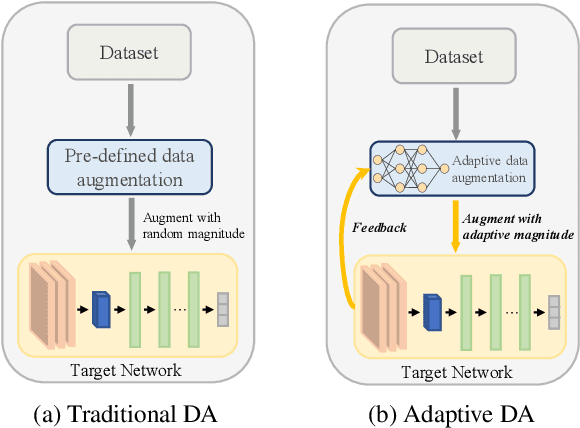

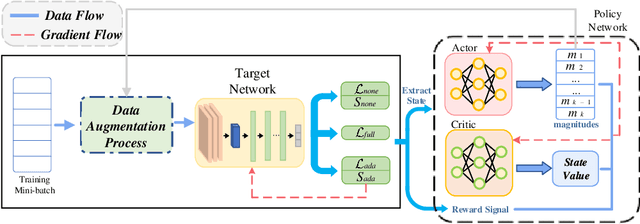

Abstract:Data augmentation (DA) is widely employed to improve the generalization performance of deep models. However, most existing DA methods use augmentation operations with random magnitudes throughout training. While this fosters diversity, it can also inevitably introduce uncontrolled variability in augmented data, which may cause misalignment with the evolving training status of the target models. Both theoretical and empirical findings suggest that this misalignment increases the risks of underfitting and overfitting. To address these limitations, we propose AdaAugment, an innovative and tuning-free Adaptive Augmentation method that utilizes reinforcement learning to dynamically adjust augmentation magnitudes for individual training samples based on real-time feedback from the target network. Specifically, AdaAugment features a dual-model architecture consisting of a policy network and a target network, which are jointly optimized to effectively adapt augmentation magnitudes. The policy network optimizes the variability within the augmented data, while the target network utilizes the adaptively augmented samples for training. Extensive experiments across benchmark datasets and deep architectures demonstrate that AdaAugment consistently outperforms other state-of-the-art DA methods in effectiveness while maintaining remarkable efficiency.
Not All Data Matters: An End-to-End Adaptive Dataset Pruning Framework for Enhancing Model Performance and Efficiency
Dec 09, 2023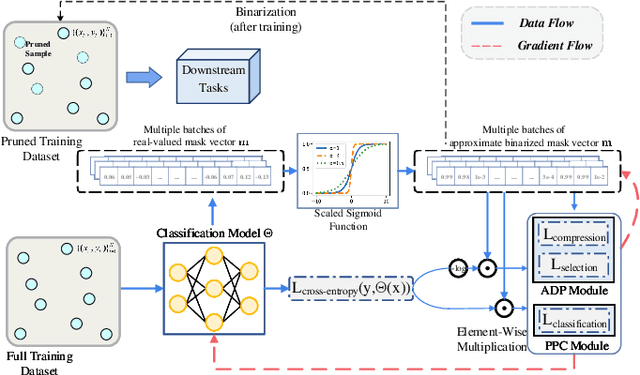



Abstract:While deep neural networks have demonstrated remarkable performance across various tasks, they typically require massive training data. Due to the presence of redundancies and biases in real-world datasets, not all data in the training dataset contributes to the model performance. To address this issue, dataset pruning techniques have been introduced to enhance model performance and efficiency by eliminating redundant training samples and reducing computational and memory overhead. However, previous works most rely on manually crafted scalar scores, limiting their practical performance and scalability across diverse deep networks and datasets. In this paper, we propose AdaPruner, an end-to-end Adaptive DAtaset PRUNing framEwoRk. AdaPruner can perform effective dataset pruning without the need for explicitly defined metrics. Our framework jointly prunes training data and fine-tunes models with task-specific optimization objectives. AdaPruner leverages (1) An adaptive dataset pruning (ADP) module, which iteratively prunes redundant samples to an expected pruning ratio; and (2) A pruning performance controller (PPC) module, which optimizes the model performance for accurate pruning. Therefore, AdaPruner exhibits high scalability and compatibility across various datasets and deep networks, yielding improved dataset distribution and enhanced model performance. AdaPruner can still significantly enhance model performance even after pruning up to 10-30\% of the training data. Notably, these improvements are accompanied by substantial savings in memory and computation costs. Qualitative and quantitative experiments suggest that AdaPruner outperforms other state-of-the-art dataset pruning methods by a large margin.
 Add to Chrome
Add to Chrome Add to Firefox
Add to Firefox Add to Edge
Add to Edge